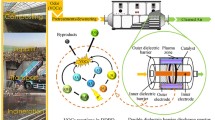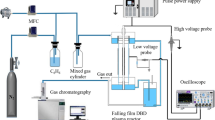Abstract
Atmospheric emissions of volatile organic compounds possess a major threat to the environment, and controlling them is a key task for air pollution prevention and control. This paper presents a comprehensive discussion on the degradation mechanism and pathways for the efficient removal of formaldehyde (HCHO) in a synthetic polluted air stream by strong ionization dielectric barrier discharge (DBD) plasma at atmospheric pressure. The effect of specific input energy, oxygen concentration, relative humidity (RH), gas residence time, and initial HCHO concentration was studied. Findings reveal that higher voltage caused an increase in discharge power, while the current density dropped from 180.53 to 55.10 mA and 71.06 to 51.99 mA when oxygen concentration and RH increased from 2.4 to 20.6% and 18.9 to 84.1%, respectively. The key degradation active species were ·O and ·OH generated from the electrical breakdown of oxygen molecules and water vapour. Also, the removal efficiency reached 95.12% for the lowest initial concentration of 100 ppm at ambient temperature. Destruction of HCHO molecules can be achieved via direct electron attack or indirect gas-phase radical reaction. The strong ionization DBD is a promising technology to remove low concentration formaldehyde from polluted air streams.







Similar content being viewed by others
References
Al Madhoun W, Ramli N, Yahaya A (2012) Monitoring the total volatile organic compounds (TVOCs) and benzene emitted at different locations in malaysia. J Eng Sci 8:61–69
Bai X, Zhang Z, Bai M, Zhu Q (2000) Non-equilibrium plasma chemistry at high pressure and its applications. Wuli 29(7):406–410
Blin-Simiand N, Pasquiers S, Jorand F, Postel C, Vacher J (2009) Removal of formaldehyde in nitrogen and in dry air by a dbd: importance of temperature and role of nitrogen metastable states. J Phys D Appl Phys 42(12):122003
Chang MB, Lee CC (1995) Destruction of formaldehyde with dielectric barrier discharge plasmas. Environ Sci Technol 29(1):181–186
Deng XQ, Liu JL, Li XS, Zhu B, Zhu X, Zhu AM (2017) Kinetic study on visible-light photocatalytic removal of formaldehyde from air over plasmonic Au/TiO2. Catal Today 281:630–635
Eichwald O, Yousfi M, Hennad A, Benabdessadok MD (1997) Coupling of chemical kinetics, gas dynamics, and charged particle kinetics models for the analysis of no reduction from flue gases. J Appl Phys 82(10):4781–4794
Feng L, Zhang B, Zhi F, Wenchun W (2017) Generation of reactive atomic species of positive pulsed corona discharges in wetted atmospheric flows of nitrogen and oxygen. Plasma Sci Technol 19(6):064008
Guo Y, Liao X, Fu M, Huang H, Ye D (2015) Toluene decomposition performance and NOx by-product formation during a dbd-catalyst process. J Environ Sci 28:187–194
Holzer F, Roland U, Kopinke F-D (2002) Combination of non-thermal plasma and heterogeneous catalysis for oxidation of volatile organic compounds: Part 1. Accessibility of the intra-particle volume. Appl Catal B Environ 38(3):163–181
Hongxiang O, Chengwu Y, Wenming Q, Songmei W, Qianqian L, Jing C, Li M (2010) Study on formaldehyde degradation using strong ionization discharge. In 2010 international conference on mechanic automation and control engineering, pp 2094–2097. IEEE
Jarraya I, Fourmentin S, Benzina M, Bouaziz S (2010) Voc adsorption on raw and modified clay materials. Chem Geol 275(1–2):1–8
Jiang L, Zhu R, Mao Y, Chen J, Zhang L (2015) Conversion characteristics and production evaluation of styrene/o-xylene mixtures removed by DBD pretreatment. Int J Environ Res Public Health 12(2):1334–1350
Karatum O, Deshusses MA (2016) A comparative study of dilute vocs treatment in a non-thermal plasma reactor. Chem Eng J 294:308–315
Karuppiah J, Reddy EL, Reddy PMK, Ramaraju B, Subrahmanyam C (2014) Catalytic nonthermal plasma reactor for the abatement of low concentrations of benzene. Int J Environ Sci Technol 11(2):311–318
Khan FI, Ghoshal AK (2000) Removal of volatile organic compounds from polluted air. J Loss Prev Process Ind 13(6):527–545
Kim H-H (2004) Nonthermal plasma processing for air-pollution control: a historical review, current issues, and future prospects. Plasma Processes Polym 1(2):91–110
Kim H, Ogata A, Futamura S (2007) Complete oxidation of volatile organic compounds (vocs) using plasma-driven catalysis and oxygen plasma. IJ PEST 1:46–51
Kriegseis J, Möller B, Grundmann S, Tropea C (2011) Capacitance and power consumption quantification of dielectric barrier discharge (dbd) plasma actuators. J Electrostat 69(4):302–312
Liang WJ, Li J, Li JX, Zhu T, Jin YQ (2010) Formaldehyde removal from gas streams by means of NaNO2 dielectric barrier discharge plasma. J Hazard Mater 175(1–3):1090–1095
Liang W-J, Ma L, Liu H, Li J (2013) Toluene degradation by non-thermal plasma combined with a ferroelectric catalyst. Chemosphere 92(10):1390–1395
Manley T (1943) The electric characteristics of the ozonator discharge. Trans Electrochem Soc 84(1):83–96
Mok YS, Nam I-S (2002) Modeling of pulsed corona discharge process for the removal of nitric oxide and sulfur dioxide. Chem Eng J 85(1):87–97
Mustafa MF, Fu X, Lu W, Liu Y, Abbas Y, Wang H, Arslan MT (2018) Application of non-thermal plasma technology on fugitive methane destruction: configuration and optimization of double dielectric barrier discharge reactor. J Clean Prod 174:670–677
Rosocha LA (2005) Nonthermal plasma applications to the environment: gaseous electronics and power conditioning. IEEE Trans Plasma Sci 33(1):129–137
Son Y-S (2017) Decomposition of vocs and odorous compounds by radiolysis: a critical review. Chem Eng J 316:609–622
Storch DG, Kushner MJ (1993) Destruction mechanisms for formaldehyde in atmospheric pressure low temperature plasmas. J Appl Phys 73(1):51–55
Vandenbroucke AM, Morent R, De Geyter N, Leys C (2011) Non-thermal plasmas for non-catalytic and catalytic voc abatement. J Hazard Mater 195:30–54
Wu A, Li X, Yan J, Yang J, Du C, Zhu F, Qian J (2017) Co-generation of hydrogen and carbon aerosol from coalbed methane surrogate using rotating gliding arc plasma. Appl Energy 195:67–79
Xu N, Fu W, He C, Cao L, Liu X, Zhao J, Pan H (2014) Benzene removal using non-thermal plasma with cuo/ac catalyst: reaction condition optimization and decomposition mechanism. Plasma Chem Plasma Process 34(6):1387–1402
Yao S, Wu Z, Han J, Tang X, Jiang B, Lu H, Yamamoto S, Kodama S (2015) Study of ozone generation in an atmospheric dielectric barrier discharge reactor. J Electrostat 75:35–42
Zhang H, Li K, Sun T, Jia J, Yang X, Shen Y, Wang J, Lou Z (2013) The removal of styrene using a dielectric barrier discharge (dbd) reactor and the analysis of the by-products and intermediates. Res Chem Intermed 39(3):1021–1035
Zhang H, Fengsen Z, Xiaodong L, Changming D (2017) Dynamic behavior of a rotating gliding arc plasma in nitrogen: effects of gas flow rate and operating current. Plasma Sci Technol 19(4):045401
Zhao D-Z, Li X-S, Shi C, Fan H-Y, Zhu A-M (2011) Low-concentration formaldehyde removal from air using a cycled storage–discharge (csd) plasma catalytic process. Chem Eng Sci 66(17):3922–3929
Zhu T, Li J, Jin Y-Q, Liang Y, Ma G (2008) Decomposition of benzene by non-thermal plasma processing: photocatalyst and ozone effect. Int J Environ Sci Technol 5(3):375–384
Zhu T, Li J, Jin Y, Liang W (2009) Study on high-frequency dielectric barrier discharge reactor structure. High Voltage Appar 45(4):1001–1009 (in Chinese)
Zhu X, Gao X, Qin R, Zeng Y, Qu R, Zheng C, Tu X (2015) Plasma-catalytic removal of formaldehyde over Cu–Ce catalysts in a dielectric barrier discharge reactor. Appl Catal B 170:293–300
Acknowledgements
This work is supported by the Zhenjiang City Key R&D Project for Social Development [SH2017056].
Author information
Authors and Affiliations
Corresponding author
Ethics declarations
Conflict of interest
The authors declare that there is no conflict of interests regarding the publication of this paper.
Additional information
Editorial responsibility: Fatih ŞEN.
Rights and permissions
About this article
Cite this article
Asilevi, P.J., Yi, C.W., Li, J. et al. Decomposition of formaldehyde in strong ionization non-thermal plasma at atmospheric pressure. Int. J. Environ. Sci. Technol. 17, 765–776 (2020). https://doi.org/10.1007/s13762-019-02476-3
Received:
Revised:
Accepted:
Published:
Issue Date:
DOI: https://doi.org/10.1007/s13762-019-02476-3




